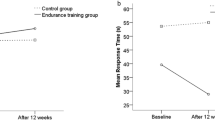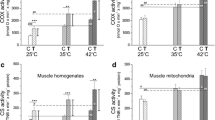Abstract
We investigated whether swim training modifies the effect of T3 treatment on rat heart response to ischemia–reperfusion. Homogenates of Langendorff preparations perfused for 25 min after 20-min ischemia were used for biochemical determinations and isolation of mitochondrial fractions. Oxidative damage and antioxidant levels of homogenates, O2 consumption and H2O2 release rates, oxidative damage, and susceptibility to Ca2+-induced swelling of mitochondria were determined. During reperfusion, hyperthyroid hearts displayed significant tachycardia and low inotropic recovery. This pattern was improved by training, which also attenuated tissue oxidative damage and glutathione depletion. Similar training effects were shown in euthyroid preparations. Moreover, training reduced mitochondrial H2O2 production and oxidative damage in hyperthyroid and euthyroid hearts and susceptibility to Ca2+-induced swelling only in the hyperthyroid ones. Rates of mitochondrial O2 consumption were not different in sedentary and trained hyperthyroid rats. However, determination of the oxidative capacity suggested that, in the sedentary rats, O2 consumption was conditioned by oxidative damage mitochondria have suffered, whereas in trained rats, it was due to changes in mitochondrial characteristics. The above results suggest that moderate training is able to reduce hyperthyroid heart susceptibility to oxidative damage and dysfunction modifying mitochondrial population.





Similar content being viewed by others
References
Åckerman KE, Wikström KF (1976) Safranine as a probe of the mitochondrial membrane potential. FEBS Lett 68:191–197
Adlam VJ, Harrison JC, Porteous CM, James AM, Smith RA, Murphy MP, Sammut IA (2005) Targeting an antioxidant to mitochondria decreases cardiac ischemia–reperfusion injury. FASEB J 19:1088–1095
Ambrosio G, Zweier JL, Duilio C, Kuppusamy P, Santoro G, Elia PP, Tritto I, Cirillo P, Condorelli M, Chiariello M, Flaherty JT (1993) Evidence that mitochondrial respiration is a source of potentially toxic oxygen free radicals in intact rabbit hearts subjected to ischemia and reflow. J Biol Chem 268:18532–18541
Barré H, Bailly L, Rouanet JL (1987) Increased oxidative capacity in skeletal muscles from acclimated ducklings: A comparison with rats. Comp Biochem Physiol 88B:519–522
Bowles DK, Farrar RP, Starnes JW (1992) Exercise training improves cardiac function after ischemia in the isolated, working rat heart. Am J Physiol 263:H804–H809
Bowles DK, Starnes JW (1994) Exercise training improves metabolic response after ischemia in isolated working rat heart. J Appl Physiol 76:1608–1614
Brady PS, Brady LJ, Ulrey DE (1979) Selenium, vitamin E, and the response to swimming stress in the rat. J Nutr 109:1103–1109
Cassina A, Radi R (1996) Differential inhibitory action of nitric oxide and peroxynitrite on mitochondrial electron transport. Arch Biochem Biophys 328:309–316
Chance B, Sies H, Boveris A (1979) Hydroperoxide metabolism in mammalian organs. Physiol Rev 59:527–605
Di Lisa F, Menabò R, Canton M, Petronilli V (1998) The role of the mitochondria in the salvage and the injury of the ischemic myocardium. Biochim Biophys Acta 1366:69–78
Gornall AG, Bardawill CJ, David MM (1949) Determination of serum proteins by means of the biuret reaction. J Biol Chem 177:751–766
Griffith OW (1980) Determination of glutathione disulphide using glutathione reductase and 2-vinylpyridine. Anal Biochem 106:207–212
Halestrap AP (1999) The mitochondrial permeability transition: its molecular mechanism and role in reperfusion injury. Biochem Soc Symp 66:181–203
Haramaki N, Packer L, Assadnazari H, Zimmer G (1993) Cardiac recovery during post-ischemic reperfusion is improved by combination of vitamin E with dihydrolipoic acid. Biochem Biophys Res Commun 196:1101–1107
Heat RL, Tappel AL (1976) A new sensitive assay for the measurement of hydroperoxides. Anal Biochem 76:184–191
Humphries KM, Yoo Y, Szweda LI (1998) Inhibition of NADH-linked mitochondrial respiration by 4-hydroxy-2-nonenal. Biochemistry 37:552–557
Hwang H, Reiser PJ, Billman GE (2005) Effects of exercise training on contractile function in myocardial trabeculae after ischemia–reperfusion. J Appl Physiol 99:230–236
Kehrer JP, Lund LG (1994) Cellular reducing equivalents and oxidative stress. Free Radic Biol Med 17:65–75
Kihlstrom M (1990) Protection effect of endurance training against reoxygenation-induced injuries in rat heart. J Appl Physiol 68:1672–1678
Lang JK, Gohil K, Packer L (1986) Simultaneous determination of tocopherols, ubiquinols, and ubiquinones in blood, plasma, tissue homogenates, and subcellular fractions. Anal Biochem 157:106–116
Langendorff O (1895) Untersuchungen am uberlebenden Saugethierherzen. Arch Ges Physiol (Pfluger) 61:291–332
Leichtweis SB, Leeuwenburgh C, Parmelee DJ, Fiebig R, Ji LL (1997) Rigorous swim training impairs mitochondrial function in postischaemic rat heart. Acta Physiol Scand 160:139–148
Liu P, Hock CE, Nagele R, Wong PYK (1997) Formation of nitric oxide, superoxide, and peroxinitrite in myocardial ischemia–reperfusion injury in rats. Am J Physiol 272:H2327–H2336
Long J, Wang X, Gao H, Liu Z, Liu C, Miao M, Liu J (2006) Malonaldehyde acts as a mitochondrial toxin: Inhibitory effects on respiratory function and enzyme activities in isolated rat liver mitochondria. Life Sci 79:1466–72
Lucas DT, Szweda LI (1998) Cardiac reperfusion injury: aging, lipid peroxidation, and mitochondrial dysfunction. Proc Natl Acad Sci U S A 95:510–514
Marcil M, Bourduas A, Ascah A, Burelle Y (2006) Exercise training induces respiratory substrate-specific decrease in Ca2+-induced permeability transition pore opening in heart mitochondria. Am J Physiol 290:H1549–H1557
Masullo P, Venditti P, Agnisola C, Di Meo S (2000) Role of nitric oxide on the reperfusion induced injury in hyperthyroid rat hearts. Free Rad Res 32:411–422
Nishiki K, Ericinska M, Wilson DF, Cooper S (1978) Evaluation of oxidative phosphorylation in hearts from euthyroid, hypothyroid, and hyperthyroid rats. Am J Physiol 235:C212–C219
Paradies G, Petrosillo G, Pistolese M, Di Venosa N, Serena D, Ruggiero FM (1999) Lipid peroxidation and alterations to oxidative metabolism in mitochondria isolated from rat heart subjected to ischemia and reperfusion. Free Radic Biol Med 27:42–50
Quiles JL, Huertas JR, Manas M, Ochoa JJ, Battino M, Mataix J (2001) Dietary fat type and regular exercise affect mitochondrial composition and function depending on specific tissue in the rat. J Bioenerg Biomembr 33:127–134
Ramires PR, Ji LL (2001) Glutathione supplementation and training increases myocardial resistance to ischemia–reperfusion in vivo. Am J Physiol 281:H679–H688
Reznick AZ, Packer L (1994) Oxidative damage to proteins: Spectrophotometric method for carbonyl assay. Methods Enzymol 233:357–363
Schild L, Reinheckel T, Wiswedel I, Augustin W (1997) Short-term impairment of energy production in isolated rat liver mitochondria by hypoxia/reoxygenation: involvement of oxidative protein modification. Biochem J 328:205–210
Starnes JW, Barnes BD, Olsen ME (2007) Exercise training decreases reactive oxygen species generation but does not attenuate Ca2+-induced dysfunction in rat heart mitochondria. J Appl Physiol 102:1793–1798
Tatchum-Talom R, Schulz R, McNeill JR, Khadour FH (2000) Upregulation of neuronal nitric oxide synthase in skeletal muscle by swim training. Am J Physiol 279:H1757–H1766
Venditti P, Agnisola C, Di Meo S (2002) Effect of ischemia–reperfusion on heart mitochondria from hyperthyroid rats. Cardiovasc Res 56:76–85
Venditti P, Costagliola IR, Di Meo S (2002) H2O2 Production and response to stress conditions by mitochondrial fractions from rat liver. J Bioenerg Biomembr 34:115–125
Venditti P, De Rosa R, Caldarone G, Di Meo S (2005) Effect of prolonged exercise on oxidative damage and susceptibility to oxidants of rat tissues in severe hyperthyroidism. Arch Biochim Biophys 442:229–237
Venditti P, De Rosa R, Cigliano L, Agnisola C, Di Meo S (2004) Role of nitric oxide in the functional response to ischemia–reperfusion of heart mitochondria from hyperthyroid rats. Cell Mol Life Sci 61:2244–2252
Venditti P, Di Meo S (1996) Antioxidants, tissue damage, and endurance in trained and untrained young male rats. Arch Biochem Biophys 331:63–68
Venditti P, Di Meo S (1997) Effect of training on antioxidant capacity, tissue damage, and endurance of adult male rats. Int J Sports Med 18:497–502
Venditti P, Di Meo S (2006) Thyroid hormone-induced oxidative stress. Cell Mol Life Sci 63:414–434
Venditti P, Masullo P, Agnisola C, Di Meo S (2000) Effect of vitamin E on the response to ischemia–reperfusion of Langendorff heart preparations from hyperthyroid rats. Life Sci 66:697–708
Venditti P, Masullo P, Di Meo S (2001) Effects of myocardial ischemia and reperfusion on mitochondrial function and susceptibility to oxidative stress. Cell Mol Life Sci 58:1528–1537
Venditti P, Masullo P, Di Meo S (2001) Hemoproteins affect H2O2 removal from rat tissues. Int J Biochem Cell Biol 33:293–301
Venditti P, Masullo P, Di Meo S, Agnisola C (1999). Protection against ischemia–reperfusion induced oxidative stress by vitamin treatment. Arch Physiol Biochem 107:27–34
Zoratti M, Szabo I (1995) The mitochondrial permeability transition. Biochim Biophys Acta 1241:139–176
Author information
Authors and Affiliations
Corresponding author
Rights and permissions
About this article
Cite this article
Venditti, P., Bari, A., Di Stefano, L. et al. Effect of T3 treatment on the response to ischemia–reperfusion of heart preparations from sedentary and trained rats. Pflugers Arch - Eur J Physiol 455, 667–676 (2008). https://doi.org/10.1007/s00424-007-0328-x
Received:
Revised:
Accepted:
Published:
Issue Date:
DOI: https://doi.org/10.1007/s00424-007-0328-x




